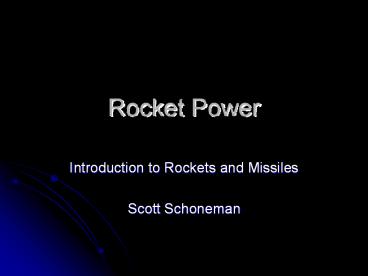Rocket Power - PowerPoint PPT Presentation
1 / 28
Title:
Rocket Power
Description:
Rocket Power Introduction to Rockets and Missiles Scott Schoneman Agenda What is a rocket? Definitions and Equations Types of Rocket Propulsion Launch Vehicles and ... – PowerPoint PPT presentation
Number of Views:1521
Avg rating:3.0/5.0
Title: Rocket Power
1
Rocket Power
- Introduction to Rockets and Missiles
- Scott Schoneman
2
Agenda
- What is a rocket?
- Definitions and Equations
- Types of Rocket Propulsion
- Launch Vehicles and Missiles
3
What is a Rocket?
- Any of a type of jet-propulsion device carrying
either solid or liquid propellants that provide
both the fuel and oxidizer required for
combustion - Encyclopedia Britannica - Produces thrust by expelling propellant at a
high velocity
4
Key Rocket Terms
- Thrust, T Force Generated By a Rocket
- Measured in pounds (lbf) or Newtons
- Impulse (or Total Impulse), I Total Energy
Produced by a the Rocket - Impulse, I Thrust x Time
- Specific Impulse, Isp Measure of Rocket Motor
Efficiency - Amount Of Energy In One Unit Of Propellant Mass
- Isp Thrust/ Weight Flow per Second)
5
Key Rocket Terms, Contd
- Effective Exhaust Velocity Average Velocity at
Which Propellant is Ejected - Mass Ratio Total Mass at Liftoff Divided by
Total Mass At Burnout - Indication of Rocket Performance Less Empty Mass
and More Propellant Are Good - Mass Fraction Percentage of vehicle (or motor)
that is propellant
6
Rocket Thrust
- Combination of Reaction to Mass Ejection and
Pressure at Nozzle Exit Plane
Force
Ma
7
Types of Rocket Propulsion
- Liquid Propellant Rockets
- Solid Propellant Rockets
- Hybrid Rockets
- Exotic Rockets
8
Liquid Propellant Rockets
- Separate Liquid Fuel and Liquid Oxidizer
- Typical Fuel/Oxidizer Combinations
- Kerosene/Liquid Oxygen (LOX)
- Liquid Hydrogen/LOX
- Alcohol/LOX
- Kerosene/Hydrogen Peroxide
- Hydrazine/Nitrogen Tetroxide (Hypergolic)
9
Saturn V Stage 1 (F-1) Motor
- Length 5.6 meters (18 feet, 4 inches)
- Maximum diameter 5.6 meters (11 feet, 11 inches)
- Weight 8200 kilograms (18,000 pounds)
- Maximum thrust at sea level 690,000 kilograms
(1,522,000 pounds) - Propellants Liquid oxygen and kerosene
- Manufactured by Rocketdyne
- Each Saturn V Stage 1 Used Five!
- (1.15 Billion lb-sec Impulse!)
10
Solid Propellant Rockets
- Fuel and Oxidizer Combined in Single Compound
- Blend of Fuels, Oxidizer, Binders to Give Desired
Characteristics - Black Powder (Model Rocket Motors)
- Aluminum Powder (Fuel)/Ammonium perchlorate
(Oxidizer)/Binder(Hydroxy-terminated
polybutadiene, HTPB)
11
Orion Solid Rocket Motors
- Built by ATK, Utah
- Used for Orbitals Pegasus, Taurus, Minotaur and
other Vehicles - Composite Case
- Diameter
- 50 in. (Orion 50)
- 38 in. (Orion 38)
12
Hybrid Rocket Motors
- Combine Solid Propellant With Liquid or Gaseous
Oxidizer - Provides Benefits of Solid Motor (Storable) with
Some Liquid Motor Benefits (Stop-Start, Variable
Thrust) - Typical Propellant Rubber, PVC
- Typical Oxidizer LOX, Nitrous Oxide
13
Exotic Motors Have Higher Isps(But Much Lower
Thrusts)
14
Launch Vehicles vs. Missiles
- Launch Vehicle Goes to Orbit
- Missile Suborbital and/or Stays In Atmosphere
(Usually at a Target)
Space Launch Vehicle (Sea Launch)
Missile (Standard Missile)
15
A Couple Missiles.
AMRAAM
AIM-9X
16
Pegasus Space Launch Vehicle
- Manufacturer Orbital Sciences Corp
- 1000 lbm to Low Earth Orbit (LEO) (100 nm)
17
Sea Launch Space Launch Vehicle
- Integrator Boeing
- Uses Russian Zenit Launch Vehicle
18
Delta Launch Vehicles
- Manufacturer Boeing
- Delta II - 891 to 2,142 kg (1,965 to 4,723 lb)
GTO and from 2.7 to 6.0 metric tons (5,934 to
13,281 lb) to low-Earth orbit (LEO). - Delta III - 3,810 kg (8,400 lb) to GTO (Approx 2x
Delta II) - Delta IV (EELV)
- Medium 4,210 kg (9,285 lb) to GTO
- Heavy 13,130 kg (28,950 lb) to GTO
19
Atlas Space Launch Vehicles
- Manufacturer Lockheed Martin
- Atlas II - payloads mass from 6,200 lb (2,812 kg)
to 8,200 lb (3,719 kg) to geosynchronous transfer
orbit (GTO). - Atlas III - payloads up to 9,920 lb (4,500 kg)
to GTO. - EELV Atlas V family is capable of lifting
payloads up to 19,114 lb (8,670 kg) to GTO.
20
Titan Launch Vehicles
- Manufacturer Lockheed Martin
- Titan II Up to 4,200 lb (1909 kg) into polar
low-Earth orbit - Titan II w/ GEM Strap-Ons Up to 7,800 lb (3545.5
kg) to polar low-Earth orbit - Titan IV gt47,800 lb into LEO or gt 12,700 lb
into geosynchronous orbit
21
Ariane Space Launch Vehicles
- Manufacturer Arianespace (European Consortium)
- Ariane 5 10,000 kg (22,000 lbm) to GTO
- Launches from French Guiana
22
Soyuz Launch Vehicle
23
Transfer Orbit Stage (TOS)
- Manufacturer Orbital
- Raises Spacecraft from Shuttle Orbit to Higher
Orbits (or Escape Velocity)
24
Orbital Launch Vehicle Family
100
Suborbital and Target Vehicles
Space LaunchVehicles
InterceptorVehicles
80
60
Length(Feet)
40
20
0
Short-RangeTargetVehicle
Medium-RangeTargetVehicle
Long-RangeTargetVehicle
Missile DefenseInterceptorBoost Vehicle
Pegasus SpaceLaunch Vehicle
Minotaur SpaceLaunch Vehicle
Taurus SpaceLaunch Vehicle
25
Minotaur Space Launch Vehicle
- Upper Stack Assembly (USA)
- 50 In. Pegasus Payload Fairing
- OSP-Standard Avionics
- Inertial Guidance
- Modular Avionics Components
- Pegasus Avionics Structure and RCS
- Orion-38 Insertion Stage 4
- Orion-50XL Stage 3
- Interstage
- Lower Stack Assembly (LSA)
- Minuteman II Boosters Stages 1 2
- Solid Rocket Motors
- Unmodified, GFE Systems
26
Minotaur Stacking Flow
27
Minotaur Mission Profile
28
Inaugural Minotaur Launch JAWSAT Mission - 26
Jan 2000

